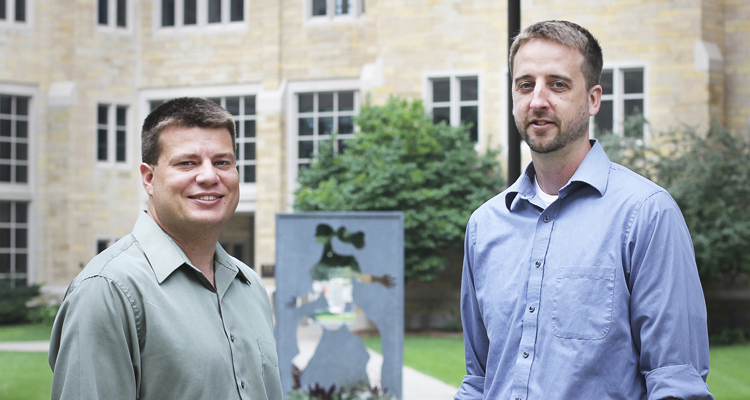The University of St. Thomas School of Engineering is relatively unique amongst engineering programs as it is rooted in the liberal arts and much of the research is carried out through faculty collaborations with undergraduates.
These characteristics, in addition to a passion for teaching, are what initially drew both of us to UST, where our personalities and research interests quickly formed into a strong collaboration. The common threads between our two research areas are that they both involve experimental fluid mechanic phenomena and that these phenomena can be examined using high-speed imaging systems.
Our focus on this method of exploring fluid mechanic phenomena comes from our background of each using high-speed imaging systems in our respective Ph.D. research projects that involved spray and bubble formations.
Within our first five months of working together we received a National Science Foundation grant to purchase a high-speed camera system capable of taking color videos at speeds up to 675,000 frames per second. This new equipment has allowed us to extend our research beyond our initial areas of expertise into projects ranging from chip formation in machining on the micro-scale to timing of basketball shots in collaboration with UST’s Department of Health and Human Performance.
Shepard grew up in Winona, Minnesota, and spent much of his time observing fluid’s ability to be a force for destruction, creation, recreation and endless curiosity. He spent a significant amount of time interacting with wind and water (technically both are fluids) while swimming, fishing, boating, sailing and windsurfing. His passion for research stems from his innate fascination with fluids combined with interest in energy issues.
His current research projects include examining fundamental issues in the formation of sprays by first injecting the liquid with bubbles, as well as studying the forces on objects as they impact water. Sprays have immediate implications in a variety of energy issues such as combustion of liquid fuels and pollution control in exhaust gases. Sprays have an auxiliary role in regards to energy in that energy is required to break a liquid up into a spray. This required energy grows for many fluids that have properties that make them difficult to spray; thus better understanding of how these difficult liquids break up may lead to more efficient spraying technologies. The primary application for studying forces on objects impacting water comes from the current technology used for measuring ocean temperatures. In this process small torpedo-shaped sensors are dropped from ships and report the ocean temperature as they fall. As these are dropped from ships of various heights, an uncertainty results in the depth at which one assumes the sensor is at for a given measurement. This creates problems for oceanographers and climate change scientists who require an accurate picture of the global energy balance.
Wentz initially started working with fluid spray behaviors while a post-doctoral researcher at the University of Illinois, Urbana- Champaign. There he became interested in the problem of extending the life of cutting tools in the creation of micro-sized features, such as those found in miniaturized medical devices. The tools used to machine these parts have frequent breaking and wear issues, as may be expected for drills and mills about half the diameter of a human hair. His research has focused on creating a cutting fluid mist through ultrasonic vibration and applying it to a micro-cutting process through a specialized nozzle.
At UST, Wentz’s work with undergraduate research assistants has yielded probabilistic and computational fluid dynamic models of the system with experimental validation of extended tool life.
Being engaged in research has proven to be of tremendous value for us in both the classroom and the academic community. Conducting research requires continuous learning, writing, confusion, critical feedback, revision, and the organization and presentation of technical material. These experiences are similar to those faced by undergraduate students. Not only can we share some lessons learned from our process, but empathy comes more easily in dealing with our students.
Additionally, by publishing and attending conferences we are able to keep abreast of many cutting-edge advancements that are then shared in the classroom and instructional labs. This helps us to strengthen the connection between our lecture material, the expanding limit of science and the practical application that our students will use in their careers. We also have enjoyed the experiences of interacting with other academics at conferences and the different perspectives toward research and pedagogy that we have found in talking with these colleagues.
A big part of the joy we feel in conducting research comes directly from the enhanced interactions with curious and talented students. In our research students ranging from first-year to seniors have been engaged in the various aspects of the projects from literature review to writing and presenting papers and everything in between. The skills and experiences the students gain help them to land engineering jobs and gain acceptance from top-tier graduate programs while providing them with the skills necessary to excel once they are there. We feel grateful to be a part of their growth and feel that the joy of discovery in research is amplified by their participation.
Clinical professor Dr. Thomas Shepard and assistant professor Dr. John Wentz both teach in UST’s School of Engineering.
From Exemplars, a publication of the Grants and Research Office.







